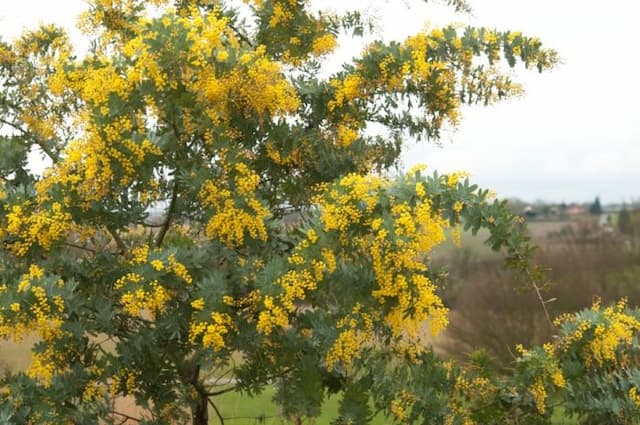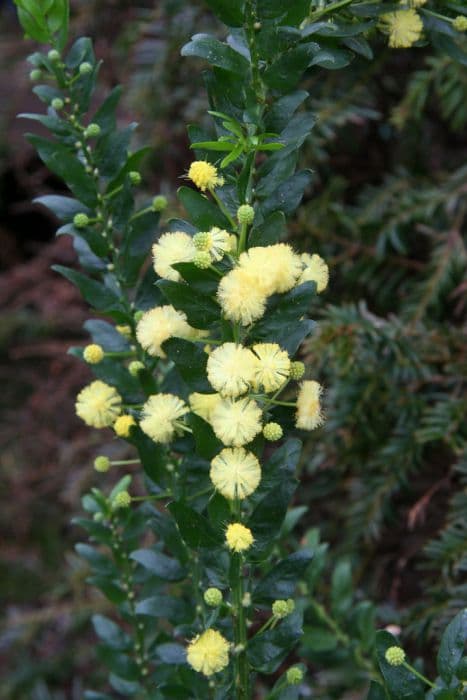Goat's Rue Galega officinalis

ABOUT
Galega officinalis, commonly known as goat's rue, is a flowering plant with a distinctive appearance. It Typically, the blooms are a light purple or lilac color, and they are small and pea-like, clustered together on elongated spikes. These flower spikes create an eye-catching display that attracts various pollinators. The foliage of goat's rue consists of bright green leaves, which are compound with oblong leaflets arranged in pairs along a central stem. The overall look of the leaves is quite airy and feathery, giving the plant a delicate texture that contrasts nicely with its robust flowering spikes. The stems of the plant are slender and upright, often branching out to create a bushy appearance. The root system is known to be vigorous, contributing to the plant's hardiness and its ability to spread in favorable conditions. Overall, goat's rue possesses a certain rustic charm, with its combination of delicate leaves and showy flowers making it a visually appealing plant in gardens and uncultivated spaces alike.
About this plant
 Names
NamesFamily
Fabaceae
Synonyms
Goat's Rue, French Lilac, Italian Fitch, Professor-weed
Common names
Galega bicolor, Galega patula, Galega persica, Galega speciosa, Galega vulgaris.
 Toxicity
ToxicityTo humans
Goat's rue, Galega officinalis, is toxic to humans if ingested. The plant contains compounds such as galegine that can lead to toxicity. Symptoms of poisoning may include nausea, vomiting, diarrhea, abdominal pain, weakness, and serious complications such as hypoglycemia (low blood sugar), which can be particularly dangerous. Large amounts of ingestion can lead to more severe symptoms including possible organ damage and can be life-threatening.
To pets
Goat's rue, Galega officinalis, is also toxic to pets, including dogs and cats. The toxic components, like galegine, can cause symptoms similar to those in humans if ingested. The ingestion can lead to vomiting, diarrhea, lethargy, and hypoglycemia. In severe cases, consumption of this plant may result in serious health complications that can be fatal for pets if not treated promptly by a veterinarian.
 Characteristics
CharacteristicsLife cycle
Perennials
Foliage type
Deciduous
Color of leaves
Green
Flower color
Varies
Height
3-4 feet (0.91-1.22 meters)
Spread
2-3 feet (0.61-0.91 meters)
Plant type
Herb
Hardiness zones
4
Native area
Middle East
Benefits
 General Benefits
General Benefits- Nitrogen Fixation: Galega officinalis, commonly known as goat's rue, has the ability to fix atmospheric nitrogen into the soil, improving soil fertility and reducing the need for chemical fertilizers.
- Forage for Livestock: Goat's rue serves as a valuable high-protein forage crop for livestock, particularly during the times when other sources are less abundant.
- Pollinator Attraction: The plant is known to attract bees and other pollinators due to its nectar-rich flowers, thereby supporting local ecosystems and benefiting nearby plant growth.
- Erosion Control: The robust root system of goat's rue can help stabilize soil and prevent erosion on slopes and banks.
- Ornamental Use: With its attractive flowers and foliage, goat's rue is sometimes grown as an ornamental plant in gardens for aesthetic purposes.
- Green Manure: It can be used as green manure, being planted and then plowed into the soil to add organic matter and nutrients, improving soil health.
 Medical Properties
Medical Properties- Galactagogue: Galega officinalis, commonly known as goat's rue, is traditionally used to stimulate milk production in nursing mothers.
- Hypoglycemic: It has been investigated for its potential to lower blood sugar levels, which can be relevant for managing diabetes.
- Diuretic: Goat's rue may increase the production of urine, helping in the treatment of conditions related to fluid retention.
 Air-purifying Qualities
Air-purifying QualitiesThis plant is not specifically known for air purifying qualities.
 Other Uses
Other Uses- Galega officinalis, commonly known as goat's rue, can be used as a natural fabric dye, producing a range of soft hues depending on the mordant used.
- The plant has been utilized historically as a forage crop for livestock due to its high nutritional content.
- Goat's rue can serve as a decorative plant in a cottage garden, offering delicate flowers and a rustic aesthetic.
- It can be included in a butterfly garden as it acts as a nectar source for pollinators like bees and butterflies.
- The dried flowers of goat's rue can be used in potpourri mixes to add natural fragrance and bulk.
- When planted alongside vegetable gardens, it can aid in biological pest control by attracting beneficial insects that prey on various garden pests.
- Goat's rue can be used in cover cropping to improve soil quality and reduce erosion in agricultural settings.
- It sometimes features in floral arrangements, especially in wildflower bouquets, for its unique inflorescence and height.
- This plant's rapid growth and dense foliage can make it a candidate for use as a natural privacy screen or green fence in landscaping.
- Its extensive root system can help with revegetation efforts aimed at stabilizing stream banks and preventing soil runoff.
Interesting Facts
 Feng Shui
Feng ShuiThe Goat's Rue is not used in Feng Shui practice.
 Zodiac Sign Compitability
Zodiac Sign CompitabilityThe Goat's Rue is not used in astrology practice.
 Plant Symbolism
Plant Symbolism- Medicinal Healing: Galega officinalis, commonly known as Goat's Rue, has been historically used in herbal medicine, symbolizing the plant's association with healing and therapeutic properties.
- Purification: Due to its medicinal uses, Goat's Rue can symbolize purification, representing the cleansing of the body from ailments or toxins.
- Protection: In some traditions, plants with healing properties are also thought to offer spiritual protection, making Goat's Rue a symbol of safeguarding against harm.
- Improvement: Given its ability to thrive in difficult conditions, Goat's Rue can embody the idea of improvement and overcoming challenges in various aspects of life.
 Water
WaterGoat's Rue prefers regular watering to maintain moist soil conditions, especially during the growing season. On average, provide about 1-2 inches of water weekly, but this can vary depending on the climate and soil type. Deep watering is beneficial as it encourages the roots to grow deeper into the ground, which can make the plant more drought-tolerant over time. Adjust the watering schedule during hot, dry periods by increasing frequency, and reduce watering in cooler, wetter months. It is crucial to avoid overwatering to prevent root rot, so ensure the soil is well-draining.
 Light
LightGoat's Rue thrives in full sun to partial shade. The ideal spot for this plant is an area that receives at least 6 hours of sunlight daily, but it can tolerate some afternoon shade, especially in hotter climates. Avoid deep shade as it may lead to poor flowering and leggy growth.
 Temperature
TemperatureGoat's Rue is hardy and can tolerate a temperature range from around 50°F to 85°F, making it suitable for many temperate climates. It can survive brief dips below freezing, but prolonged exposure to temperatures below 50°F may harm the plant. The ideal temperature range is between 60°F and 75°F for optimal growth.
 Pruning
PruningPruning Goat's Rue helps to maintain a tidy appearance and can encourage more blooms. Prune in early spring to remove any dead or damaged growth and to shape the plant. Additionally, deadhead spent flowers regularly to promote continuous blooming throughout the season. The best time for extensive pruning is after the plant has finished blooming in the fall.
 Cleaning
CleaningAs needed
 Soil
SoilGoat's rue thrives in well-draining soil with a loamy to slightly clayey texture, rich in organic matter. Ideal pH for goat's rue is around neutral, from 6.5 to 7.5. A mixture of two parts garden soil, one part sand, and one part compost or well-rotted manure can create an optimal environment for this herbaceous perennial.
 Repotting
RepottingGoat's rue generally does not require frequent repotting and can thrive well when allowed to grow without disturbance. If necessary, repotting can be done every 2-3 years or when the plant has outgrown its current container to ensure continued growth and bloom.
 Humidity & Misting
Humidity & MistingGoat's rue prefers average humidity levels and does not require any special humidity considerations. It will perform well in the natural outdoor humidity levels found in its growing zones.
 Suitable locations
Suitable locationsIndoor
Ensure bright light, minimal watering, and good air flow for indoor goat's rue.
Outdoor
Choose sunny spot, water regularly, and protect from strong winds for outdoor goat's rue.
Hardiness zone
4-8 USDA
 Life cycle
Life cycleGalega officinalis, commonly known as Goat's rue, germinates from seed, typically in the spring when soil temperatures rise. It first develops a rosette of leaves at the base, relying on stored energy in the seed. As the plant matures, it grows upright stems and leafy branches, forming a bushy appearance. Flowering occurs in the late spring to summer, presenting with tall spikes of purple, white, or pink flowers that are attractive to pollinators. After pollination, seeds develop within the pods and are eventually released to the environment for dispersal. Goat's rue is a perennial plant, meaning it can survive through the winter and regrow from its root system in subsequent years, continuing its life cycle.
 Propogation
PropogationPropogation time
Spring to summer
Galega officinalis, commonly known as goat's rue, is typically propagated by seed or division. The most popular method of propagation for this plant is by seed. Seeds are sown in late winter or early spring in either a cold frame or directly outdoors once the soil can be worked. It is important to space the seeds about 1 inch apart, covering them lightly with soil. Goat's rue seeds require light to germinate, so they should not be buried too deeply. Once the seedlings have developed true leaves and have grown sufficiently, they should be thinned to about 18 inches apart to allow ample room for growth. Regular watering is crucial during the initial stages of growth until the plants are well-established.









